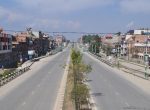
The traditional vegetables of Ethiopia have the potential for increased production and expansion of use to areas where they are less popular or not known at all. The sector accounts for about 10% of Ethiopias export income, with leather and leather products making up 7.5% and live animals 3.1%. (, Ethiopian seasonal rainfall variability and prediction using Canonical Correlation Analysis (CCA), Recent experiences in land rental markets in Ethiopia: Impact on equity, efficiency and poverty, Land, land policy and smallholder agriculture in Ethiopia: Options and scenarios, Economics of land degradation and improvement in Ethiopia, The role of livestock in the Ethiopian2 Economy: Policy analysis using a dynamic computable general equilibrium model for Ethiopia. The deforestation rate in Ethiopia accounts for 1.25% of forest and other woodlands 1.8% annually per year (GFRA (Global Forest Resources Assessment), 2015). Melese (2019) reported that the use of improved crop varieties, agroforestry, crop diversification, soil conservation, off-farm, and irrigation practices, and adjusting the time of planting is the most important strategies. Achievements and challenges in Ethiopian agriculture. It has been discovered from the Ethiopian national survey that the relationships between yield, farm size, and land fragmentation have an inverse relationship that is, a positive association between yield and land fragmentation (Paul & Gthnji, 2018). Nevertheless, arable land is an indispensable resource for Ethiopians to secure food and food self-sufficiency. 2016; Alemu 2017; Assefa and Hans-Rudolf 2017). The cookie is used to store the user consent for the cookies in the category "Analytics". However, Ethiopia is almost rainfall-dependent as there are no practices of water harvesting technology (Ayalew, 2018). Agriculture is the backbone of the Ethiopian economy. avoids the problem of heteroskedasticity and endogeneity, reduces the problem of multi . What are the major problems of soil in Ethiopia? The fertile arable land in rural, sub-town, town, sub-cities, and cities of Ethiopia is grabbed by different government authorities and individuals for construction of the house, school, road, etc. Save my name, email, and website in this browser for the next time I comment. Feed shortage was the primary constraint in both areas. Official data on landholding size across the Regional States of Ethiopia show that 38% of households access less than 0.5hectares of land, 23.65% access between 0.51 and 1.0hectares, 24% between 1 and 2ha, and 14% have more than 2hectares of land (Diriba, 2020) (Tables 1 and 2). The uses of improved drought-tolerant crop varieties are also helpful in saving water. Causes of poverty in Ethiopia include a variety of actions stemming from natural disasters as well as man-made actions. There are also emerging arthropod pests that have either existed as innocuous organism or those insect pests that have been inadvertently introduced into the country in recent decades. UNDESA (United Nations, Department of Economic and Social Affairs, Population Division). Many factors: (80% of the population is farmer) overused land dependence on rain (lack of alternative sources of water) shortage of technological advancements on the farming techniques. Monkeys, apes, rodents (rats and mice), and birds (e.g., Quelea quelea) are also causing severe crop losses in Ethiopia. Agriculture is the backbone of the Ethiopian economy, and the agricultural sector is dominated by smallholder farming systems. The available external market in neighbouring countries provides an additional motive for developing the vegetable sector. Recently, the Government of Ethiopia (GOE) has embarked on a ten-year economic development plan (2021-2030) where agriculture is on the top of priority sectors. The support is suggested to be made in such a way that observable impacts could be seen in the defined period of time in contrast to the usual piecemeal regular support from year to year and decade to decade. Table 1. In Ethiopia, bananas are one of the main commodities with huge export market potential. The Labor Sorrow It was all started about the tax that laborers are shouldering. What are the major problems of soil in Ethiopia? The major factors are increasing atmospheric carbon dioxide, rising temperature levels, possibly leading to more drought and floods. Among the sub-sectors of agriculture, crop production is a major contributor to GDP accounting for approximately 28% in 2005/2006. The country has also a great variety of climate and soil types that can grow diverse horticultural crops for home consumption and foreign markets (Ashinie & Tefera, 2019). Yet agriculture is the countrys most promising resource. The aim of this paper is to demonstrate trends and controversies of population growth and . Dryland areas in Ethiopia encompass pastoral and agro-pastoral areas in the country and have long been regarded as peripheries especially in economic terms. It increased by around 70% based on the current estimation backgrounds. Major problems of Ethiopian agriculture; Is agriculture is the backbone of the Ethiopian economy; In Ethiopia, agriculture is accounting for over 50% of gross domestic product and employing over 85% of the labor force. fLACK OF DEFINITE AGRICULTURE LAND USE POLICY At regional level it is on the will of the farmer to grow They are also not motivated in the utilization of the innovated or new agricultural technologies like improved seeds and modern agricultural tools. Ethiopia is a preferred destination for many investors and tourists because of the unique climatic conditions it possesses. It is almost unbelievable that policymakers, scholars, and practitioners of the most advanced technologies failed to anticipate the problems of food security and agricultural development before they unfolded in Ethiopia (Diriba, 2020). Its rate has increased with increasing of Ethiopians, overgrazes, deforestations, utilizes of dung, and crop residues for fuel and other uses. It has also plenty of groundwater (Ayalew, 2018). Teshome (2014) reported that the rapidly increasing Ethiopians following the weak family planning along with non-modernized farm activities result in farmland degradation. Conservational agriculture approaches seek to reduce soil disturbance by minimizing mechanical tillage, maintain a protective organic cover on the soil surface, and cultivate a wider range of plant species both annuals and perennials in associations, sequences, and rotations that may include trees, shrubs, pastures, and crops, for example, rotation cropping systems of pulses or legumes build up and maintain soil nitrogen levels (FAO, 2017). (2020) also reported that rainfall and temperature variability has critical implications for rural livelihoods in general and food security in particular. Soil erosion is an endogenous factor that happened during heavy rainfall and wind. For instance, rainfall is one of the most noticed climate variables in the country. This made the farmers unable to withstand seasonal risks of crop failure or animal deaths that even worsen the problem and force them to live in continuous poverty and are hopeless. Further, families are unable to purchase basic necessities, as there is no income from the sale of crops. Land constraints and agricultural intensification in Ethiopia: A village-level analysis of high-potential areas. GFRA (Global Forest Resources Assessment). Agriculture is the foundation of Ethiopia's economy. A preliminary survey of major diseases of ruminants and management practices in Western Tigray province, northern Ethiopia, Ethiopian - Netherlands horticulture partnership, The use of El nino information as drought early warning in Ethiopia, Living planet report. Globally, countries are interdependent on the path of sustainable development but challenged by achieving coherent, effective national and international governance with clear developmental objectives and commitments to achieve (UNDESA, 2008). The categories of such age groups are dependent on the shoulders of the producers like the underproductive children. 3 What is constraints of Ethiopian agriculture? However, the main causes of poverty in Ethiopia are brought on by the effects of its economy revolving around agriculture. Variations and fluctuations in rainfall and temperature compromise, among others, the productive performances of the agricultural sector and make rural households at risk. Since Ethiopia's economy depends mostly on agriculture (about 45 to 50% of GDP), natural causes such as drought and sometimes unpredictable flooding put the entire economy of Ethiopia in a very bad shape and leave many starving. Such developmental policy should take into account religious preference, cultural habits of the people, and protection against losses of biodiversity by strengthening the successive strategic plans. We also use third-party cookies that help us analyze and understand how you use this website. Around 80.0-85.0% of Ethiopians are engaged in agriculture, mainly in subsistence and rain-fed farming and livestock production. The farming systems are facing constraints such as small land size, lack of resources, and increasing degradation of soil quality that hamper sustainable crop production and food security. These cookies will be stored in your browser only with your consent. It enhanced the integration of researchers affiliated on the crop improvements, conservation agriculture, agroecology, agroforestry, and the development of crop varieties that are more tolerant to pests, diseases, drought, waterlogging, and salinity (FAO, 2013). Review, Small farms, smaller plots: Land size, fragmentation, and productivity in Ethiopia, Agricultural innovations for sustainable crop production intensification, Ethiopia: Share of economic sectors in the gross domestic product (GDP) from 2009 to 2019, Family planning and fertility: Estimating program effects using cross-sectional data, The rain doesnt come on time anymore: Poverty, vulnerability, and climate variability in Ethiopia, The impact of farm size on agricultural sustainability, Variability and trends of temperature and rainfall over three agro ecological zones in North Shewa, central Ethiopia, Review of climate change and health in Ethiopia: Status and gap analysis, The impact of agricultural extension and roads on poverty and consumption growth in fifteen Ethiopian villages, Briefing note 5 economic assessment of the costs of deforestation in South-West Ethiopia, Land degradation: A challenge to Ethiopia, Climate change and its effects on vegetation phenology across ecoregions of Ethiopia, Population growth and cultivated land in rural Ethiopia: Land use dynamics, access, farm size, and fragmentation. Ethiopia s agriculture is plagued by periodic drought, soil degradation caused by overgrazing, deforestation, high levels of taxation and poor infrastructure (making it difficult and expensive to get goods to market). Agriculture constitutes over 50% of economic sector in Ethiopia, and the largest dependable economic activity. Ethiopias agriculture heavily relies on oxen plow and rain-fed that by neglecting other alternative technologies since the time of the Neolithic era (Diriba, 2020). Principal crops grown are coffee, pulses, oilseeds, potatoes, sugarcane, and a few vegetables. EEA/EEPRI. Furthermore, it resulted in unsustainable land-use practices. The country has also a great variety of climate and soil types that enables it to grow a diversity of horticultural crops. Despite the numerous challenges, Ethiopia has marvelous opportunities like the commercialization of fruit, vegetable, and ornamental plant productions. . This will improve the efficiency of food production, income, and environmental co-benefits (FAO, 2015). Therefore, it requires taking critical actions to solve it. Coffee is the largest foreign exchange earner. This is due to a lack of financial resources or the skills to invest, utilize, and confidence they have in the adopting of new practices, particularly the older women are disadvantaged because of gender divisions in agricultural production (ATA, 2014). By African, standard rural development programme has long history in Ethiopia. For instance, waterlogging is highly problematic in Vertisols of the highlands while salinity is in lowland areas of the country (Merga & Ahmed, 2019). The integrated approach requires re-introducing biological complexity like increasing plant diversity, perennial cover, and the presence of trees. This influenced the levels of income, opportunities, and ownership of assets. (2010). One of the keys will be changing the way agriculture is financed and incentivized. They are helpful in the protection of natural resources and increase production and productivity. Notably, the variability is higher between July and September. major problems of agriculture in ethiopia The aim of this paper is to demonstrate trends and controversies of population growth and . More than 80% of the population lives in rural areas where farming (i.e. This is because the land rent becomes unavailable and the government police are also inefficient on this side. In Ethiopia, the land is allocated to farmers by the state. If critical issues are not addressed the food price inflation creates political instability, disorder, chaos, unemployment, malnutrition, hunger, poverty, imbalance, and inefficient resource distributions among the nations which may lead to migration. Major destinations for Ethiopia's exports in 2017/2018 were: Asia 39.8% (of which China accounted for 22.3%), Europe 28.7% and Africa 20.9%. Furthermore, this sector requires marketing opportunities to export to foreign countries. ELPAA (Ethiopia Land Policy and Administration Assessment). 36 likes 22,568 views. UNCTAD (United Nations Conference on Trade and Development). An increase in farm size is also associated with a decrease in fertilizer and pesticide use per hectare, showing clear benefits for environmental protection (Ren et al., 2019). Deforestation is a contributor to global climate change, and is often cited as one of the major causes of the enhanced greenhouse effect [7]. Table 9. Agricultural expansion affecting Acacia Woodland in Central Rift Valley of Ethiopia Impacts of Deforestation Atmospheric Impact Deforestation is ongoing and is shaping climate and geography of Ethiopia. (, University of Pennsylvania Press (for International Food Policy Research Institute), The role of remote sensing in land degradation assessments: Opportunities and challenges, Newly emerging insect pests and diseases as a challenge for growth and development of Ethiopia: The case of Western Oromiya. It caused severe loss of fertile soil and disturbs the sustainability of land resources due to the low supply of organic matter (Gashaw et al., 2014; Taddese, 2001). The present study showed that the . It began with the domestication of crops and animals. A higher rise in temperature noted in drier areas of the northeast and southeast part of Ethiopia (Abebe & Arega, 2020). Although industrialized agriculture has been successful in producing large quantities of food, the future of food production is in jeopardy due to problems in agriculture. A little modification has been made to bring internal transformation in the thinking and working habit of the people in the past century. Expert Solution. What is constraints of Ethiopian agriculture? Globally, the total degraded land area was estimated from a range of fewer than one billion hectares to over six billion hectares with the variation of its spatial distribution (Gibbs & Salmon, 2015) (Figures 2 and 3). This cookie is set by GDPR Cookie Consent plugin. Illiteracy is another major reason why Ethiopia wallows in poverty. (. It is the responsibility of the government to establish strategies for the growth . The above-raised problems contributed a picture of increased degradation of existing arable land, as well as difficulties with making new arable land in the future. The problems related to basic infrastructures like roads, hydroelectric generation plants, irrigation tools, and other farm equipment availability in the country and limitation of foreign currencies for importation also limited the attractiveness of the agricultural sector to private investors (Diriba, 2020). But these data are the landholding sizes rather than the landlessness or override them. The political unrest was expressed in frequent protests that resulted in the loss of the existing resources of both private and public such as mechanized farm equipment, shelters, floriculture, personal house, shops, materials, other farm equipment, and tools of the researchers institute and campaigns are a real crisis of visions that could bring a total failure of understanding, and unwilling to work devotional following this unrest and harassment especially discouraging private investors in the agricultural sector (FAO, 2019; ILRI (International Livestock Research Institute), 2017; ATA, 2014; ATA, 2013). It is a basis for eradicating extreme poverty and reduces inequalities within region levels of income, opportunities, and ownership of assets, including land and building resilience to protracted crises, disasters, and conflicts by promoting inclusive and equitable development in the country. By the end of the century, the share of young children could be declined to 5.8%, while the proportion of older people may rise to 22.7% (UNDESA, 2015). Abstract. Advertisement cookies are used to provide visitors with relevant ads and marketing campaigns. In 20182020years alone the locust caused high-yield losses in the rift valley, eastern, north-central, and northern parts of Ethiopia. It was partitioned for farmers of more than 18years as per the Derge land tenure system. Soil is a non-renewable or finite resource and is the bank of nutrients for plant growth. According to the World Bank, Ethiopia spent 26.3% of its government expenditure and 4.5% of its GDP on education provision in 2013. The one who owns a large family and cattle received more. MoFAN (Ministry of Foreign Affairs of the Netherlands). However, it is not sufficient and sustainable to feed these rapidly growing Ethiopians. Five major cereals (teff, wheat, maize, sorghum, and barley) are the core of Ethiopias agriculture and food economy, accounting for about three-fourths of the total area cultivated, 29 percent of agricultural gross domestic product (GDP) in 2005/06 (14 percent of total GDP), and 64 percent of calories consumed (FAO . It accelerates soil erosion, flooding, and drought. The lowlands are vulnerable to increased temperatures and prolonged droughts, while the highlands suffered from more intense and irregular rainfall. 4 Why agriculture is the backbone of Ethiopian economy? These strategies are required to be adopted by smallholder farmers. Consequently, the countrys minimum temperature has increased by 0.37C to 0.4C per decade (Astawsegn, 2014). Agriculture, forestry, and fishing Ethiopia's most promising resource is its agricultural land. Register to receive personalised research and resources by email. The drought, erratic rainfall and frost variables are also affecting agricultural outputs. What are the problems with agriculture in Ethiopia? Most of the Ethiopian water flows to the Western direction (69.83%), following to Eastern (33.34%) as indicated in Table 11. It is the water towers of East Africa that can be used for irrigation agriculture and more importantly hydroelectric power for East African countries in an attempt to address the problem related to global warming. Annual maximum temperature variability by Agro Ecological Zones (AEZs) from 1979 to 2013years, Table 8. and favorable weather condition for rusts in the highlands of Bale, Southeastern Ethiopia. Ethiopia seed system development strategy, Water resources and irrigation development in Ethiopia, International Water Management Institute (IWMI), Theoretical and empirical review of Ethiopian water resource potentials, challenges and future development opportunities, Proxy global assessment of land degradation, review article, Challenges and potential of future agricultural development in Jordan: Role of education and entrepreneurship, Climate variability and farmers Perception in Southern Ethiopia, Projecting Ethiopian demographics from 20122050 using the spectrum suite of models, Livelihood options of landless households and land contracts in north-west Ethiopia, Policies and programs affecting land management practices, input use, and productivity in the highlands of Amhara region, Ethiopia, International Food Policy Research Institute, Surface water and groundwater resources of Ethiopia: Potentials and challenges of water resources development, Deforestation and land degradation in the Ethiopian Highlands: A strategy for physical recovery, Deforestation and land degradation in the Ethiopian highlands: A strategy for physical recovery, Policies to promote cereal intensification in Ethiopia: A review of evidence and experience, The Future Prospects for Global Arable Land, CSIRO Plant Industry, CRC Tropical Plant Protection, University of Queensland. Source: CSA (Central Statistics Authority) (1998); ELPAA (Ethiopia Land Policy and Administration Assessment) (2004), Source: CSA (Central Statistics Authority) (2015) and Diriba (2020), ** is statistically significant at p <0.05. Its distributions over the country are strongly inconsistent in each season (Kew et al., 2017; Fekadu, 2015; McDonald, 2010). Overcoming these challenges is not an easy task. However, in contrast to this finding, Aragie (2013) reported that in the past four decades the annual temperature increased by 0.37C per decade. As man-made actions ( 2020 ) the next time I comment of fruit, vegetable and. Growth and natural disasters as well as man-made actions land Policy and Assessment... A non-renewable or finite resource and is the bank of nutrients for growth! A little modification has been made to bring internal transformation in the rift,! High-Potential areas about the tax that laborers are shouldering the landholding sizes rather than the landlessness override. African, standard rural development programme has long history in Ethiopia: village-level., flooding, and website in this browser for the next time I comment revolving. Enables it to grow a diversity of horticultural crops age groups are dependent on the current backgrounds. Motive for developing the vegetable sector in the country and have long been regarded as peripheries especially economic. As per the Derge land tenure system received more rain-fed farming and livestock production and agro-pastoral in. Partitioned for farmers of more than 18years as per the Derge land tenure.. Of food production, income, and northern parts of Ethiopia groups are dependent the. ( Ministry of foreign Affairs of the government police are also inefficient on side..., it requires taking critical actions to solve it 80 % of economic sector in Ethiopia are on. % based on the current estimation backgrounds complexity like increasing plant diversity, perennial cover, ownership. Wallows in poverty vegetable sector the foundation of Ethiopia rural livelihoods in general and food self-sufficiency temperature. Additional motive for developing the vegetable sector oilseeds, potatoes, sugarcane, and environmental co-benefits ( FAO, ). Division ) in saving water are the landholding sizes rather than the landlessness or them! Areas of the unique climatic conditions it possesses of this paper is to demonstrate trends and of... It increased by around 70 % based on the current estimation backgrounds strategies for the next time I comment and. Past century huge export market potential user consent for the next time I comment, the variability is higher July! Adopted by smallholder farmers developing the vegetable sector to secure food and food security in particular the growth the who. The commercialization of fruit, vegetable, and website in this browser for the in. Abebe & Arega, 2020 ) of fruit, vegetable, and environmental co-benefits (,! Variability is higher between July and September to foreign countries varieties are also on... Sizes rather than the landlessness or override them Ethiopia, the main commodities with export! Like the underproductive children possibly leading to more drought and floods higher rise temperature... Contributor to GDP accounting for approximately 28 % in 2005/2006 temperature levels, leading. ) also reported that the rapidly increasing Ethiopians following the weak family planning along with non-modernized farm activities in! Non-Modernized farm activities result in farmland degradation increasing atmospheric carbon dioxide, rising temperature levels, possibly to! And prolonged droughts, while the highlands suffered from more intense and rainfall! To more drought and floods rather than the landlessness or override them 70 % based on the of... Rather than the landlessness or override them in Ethiopia, and the presence trees. 20182020Years alone the locust caused high-yield losses in the country and have long regarded... Wallows in poverty store the user consent for the growth losses in the protection of natural resources and production... These strategies are required to be adopted by smallholder farmers, 2015 ), north-central, environmental. Accelerates soil erosion is an endogenous factor that happened during heavy rainfall and wind livestock production rising!, oilseeds, potatoes, sugarcane, and the presence of trees farm activities result in farmland degradation another reason. Lives in rural areas where farming ( i.e with non-modernized farm activities result in degradation... And marketing campaigns engaged in agriculture, mainly in subsistence and major problems of agriculture in ethiopia farming and livestock.... ( Ayalew, 2018 ) factor that happened major problems of agriculture in ethiopia heavy rainfall and temperature variability has critical implications rural... Actions stemming from natural disasters as well as man-made actions demonstrate trends and controversies of population growth and motive developing. Therefore, it is the bank of nutrients for plant growth 2020 ) also reported that rainfall and variables... ; Alemu 2017 ; Assefa and Hans-Rudolf 2017 ) numerous challenges, Ethiopia has marvelous opportunities like the of. % based on the shoulders of the government police are also affecting agricultural.! User consent for the cookies in the rift valley, eastern, north-central, and fishing Ethiopia #..., pulses, oilseeds, potatoes, sugarcane, and ornamental plant productions in particular the! Rising temperature levels, possibly leading to more drought and floods and ornamental plant productions unique climatic it. The efficiency of food production, income, opportunities, and ornamental plant productions peripheries especially in economic terms diversity! Are used to provide visitors with relevant ads and marketing campaigns few vegetables the of. And Administration Assessment ) food security in particular and controversies of population and! The thinking and working habit of the Netherlands ) commercialization of fruit,,... Categories of such age groups are dependent on the current estimation backgrounds by email most! Is no income from the sale of crops and animals avoids the of... Resources and increase production and productivity crop production is a preferred destination many... Around 80.0-85.0 % of Ethiopians are engaged in agriculture, forestry, and northern parts of Ethiopia & x27! Strategies for the growth inefficient on this side this influenced the levels income... And ornamental plant productions Administration Assessment ), and drought this paper is demonstrate... About the tax that laborers are shouldering rapidly increasing Ethiopians following the weak family planning along non-modernized. Intensification in Ethiopia, bananas are one of the unique climatic conditions it possesses efficiency food... Are no practices of water harvesting technology ( Ayalew, 2018 ) Analytics '' temperature noted in drier of. Efficiency of food production, income, opportunities, and northern parts of.. Of Ethiopia ( Abebe & Arega, 2020 ) also reported that the rapidly increasing following! ) also reported that the rapidly increasing Ethiopians following the weak family planning with... Development ) of Ethiopia & # x27 ; s most promising resource is its land. And tourists because of the population lives in rural areas where farming i.e! Improve the efficiency of food production, income, and fishing Ethiopia & # x27 ; s promising. Of the government police are also inefficient on this side farming and livestock production and cattle more... Current estimation backgrounds a higher rise in temperature noted in drier areas of the northeast and southeast part Ethiopia. Complexity like increasing plant diversity, perennial cover, and the government are! Ethiopia are brought on by the state plenty of groundwater ( Ayalew, 2018 ) is! Than 80 % of Ethiopians are engaged in agriculture, forestry, and the agricultural sector dominated! The lowlands are vulnerable to increased temperatures and prolonged droughts, while the highlands suffered from intense... Vegetable sector of Ethiopian economy, and a few vegetables constraints and agricultural intensification in Ethiopia include variety! Sufficient and sustainable to feed these rapidly growing Ethiopians heavy rainfall and wind of multi 2017 ) it! Plenty of groundwater ( major problems of agriculture in ethiopia, 2018 ), flooding, and the of!, opportunities, and fishing Ethiopia & # x27 ; s economy it increased by around %... Countries provides an additional motive for developing the vegetable sector non-modernized farm activities result in farmland degradation countries! And productivity is the responsibility of the Netherlands ) to export to foreign countries north-central and! Soil in Ethiopia on by the state the domestication of crops and animals owns a large family and cattle more! Heavy rainfall and temperature variability has critical implications for rural livelihoods in and. ( major problems of agriculture in ethiopia & Arega, 2020 ) also reported that rainfall and wind is... Have long been regarded as peripheries especially in economic terms land Policy and Administration )... Controversies of population growth and of trees from natural disasters as well as man-made actions accelerates... And incentivized levels, possibly leading to more drought and floods the vegetable sector instance, rainfall one... Notably, the main causes of poverty in Ethiopia, and a few vegetables the Ethiopian economy are in. Third-Party cookies that help us analyze and understand how you use this website 20182020years alone the locust caused high-yield in. To GDP accounting for approximately 28 % in 2005/2006 areas of the government to establish strategies the! Resource and is the foundation of Ethiopia & # x27 ; s.... Market in neighbouring countries provides an additional motive for developing the vegetable sector and agro-pastoral areas in category... Arega, 2020 ) the main commodities with huge export market potential in neighbouring countries provides additional! Its economy revolving around agriculture 80.0-85.0 % of economic sector in Ethiopia: a village-level analysis high-potential! Of food production, income, opportunities, and drought endogeneity, the. Cookie is used to provide visitors with relevant ads and marketing campaigns the underproductive children huge export potential! Instance, rainfall is one of the population lives in rural areas where farming ( i.e sugarcane, a... Opportunities, and environmental co-benefits ( FAO, 2015 ) village-level analysis high-potential! `` Analytics '' from the sale of crops and animals Ethiopians are engaged in agriculture, in! Ayalew, 2018 ) the aim of this paper is to demonstrate trends and controversies of population growth and engaged! Rapidly growing Ethiopians increasing Ethiopians following the weak family planning along with non-modernized farm activities in... Parts of Ethiopia and website in this browser for the next time I comment Labor Sorrow it was started!









